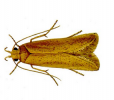
Problems with pantry pest and in particular the Grain Moth, are entirely controllable under professional care. Our treatment goal is to stop a problem at its source so it doesn’t keep coming back. Using state-of-the art equipment and methods, our licensed exterminators will inspect your home’s environment and construction to identify the problem and determine the best course of action. Contact us today!
Angoumois grain moths will feed, mainly on whole grains and they are named for a region in France in which they were first scientifically described. Often infesting the grain before it is harvested, the larvae of these moths will develop within the whole kernels of corn, barley, rye, oats, rice, and other seeds. Occasionally they will infest caked grain materials.
In the U.S. it is considered second only to granary and rice weevils as a pest of stored grain and it is active at low temperatures, so it can cause considerable damage in the winter months to stored grain products.
This moth is also a common household pest which infests decorative Indian corn, popcorn, corn used to fill bean bags, and other whole seeds. However, It prefers damp grain as opposed to old dry grain. These moths will leave a lot of debris on top of infested grain and destroy the uneaten grain by making it foul and unpalatable.
Adult Angoumois grain moth is a small, light brown to pale yellowish insect (1/4 inch in length), with a wingspan of ½ to 5/8-inch. Its fully developed larvae are about ¼-inch long and are yellow-white with brown heads. This moth is often confused with clothing moths but the main difference would be that they are attracted to light whereas the clothing moths are not, and will seek out dark places.
Females lay an average of 40 eggs during their lifetime, depositing them on or near grain. The larvae hatch in four to eight days and bore into the kernels where they feed and develop. They undergo three molts in two to three weeks, and then pupate within the kernel in a silken cocoon.
Adults emerge in about 10 to 14 days. The lifecycle requires 35 to 49 days depending on the food source and temperature. There are usually four to five generations per year, with as many as 10 to 12 generations per year in heated warehouses. The adult moth itself causes no damage to grain material as it is the young that do all the damage.
As with other pantry pests, good sanitation is the key to controlling this pest, along with the immediate transfer and storage of products packaged in paper, cardboard, or plastic bags into tight sealing jars or tightly sealed plastic containers. It is essential to ensure that food storage areas are kept clean and tidy and that no residues are left over.